
Online communities have become an integral part of how brands do business online. Benefits include providing customer support, increasing customer engagement, and gathering customer insights.
There are many online community platforms to choose from, including free and popular ones like Facebook Groups. Choosing a platform that compliments your online business can easily become a challenge. For this reason, I’ve put together a list of the 7 best community platforms for brands in 2025 to help you decide.
Many of these options give you access starting with a free trial so you can start building with minimal investment. Some even integrate courses so that you can build a learning community.
Check out the top 7 options for the best community platforms online and see how they can help your business.
This post may contain affiliate links. TrialBear earns commissions at no extra cost to you when purchases are made through links on this page. For more info, visit the disclosure page.
How To Choose The Best Community Platform
Not all community platforms are created the same. You’ll want to choose a platform that makes it easy for you to run your online business.
Here’s what to look for when you’re checking out different options for online community platforms.
The top community platforms check all of the above boxes but it isn’t necessary for a great community platform to have them all.
You will know what works best for you and choose a community platform that allows you to grow your business effectively.
1. Mighty Networks
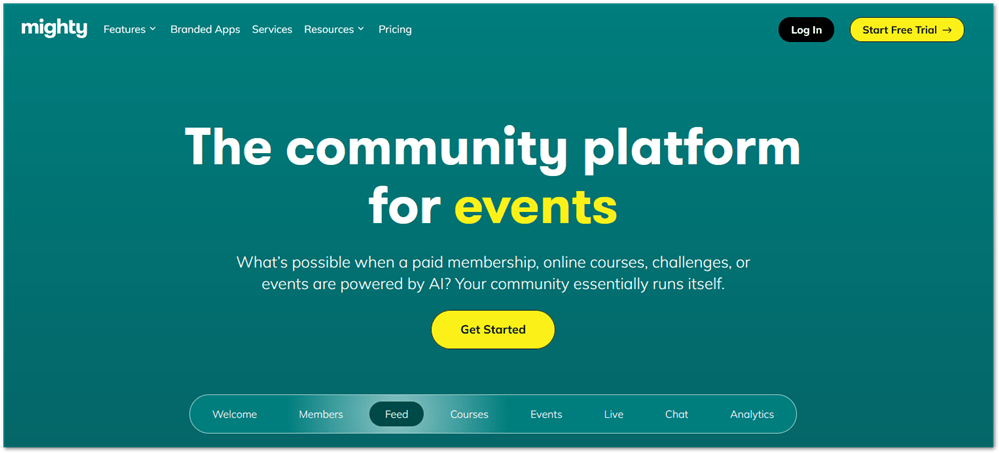
When it comes to building a community, there is no better platform to do so than Mighty Networks.
There are a number of reasons why Mighty Networks tops the list. The Mighty Pro experience alone puts this platform ahead of the competition and that is packed with everything you can get from their most all-inclusive web plan.
Mighty Pro allows brands to have a white-label mobile app for iOS and Android devices. Push notifications and more can get your members engaged in an environment that was built for focus.
Mighty Networks has very strong community features such as member direct messages, group chats, live streaming, topics, profiles, and online or in-person events. Members can see and connect with others who are located near them.
For creators, there are lots of tools and resources available for you to build a successful and thriving community. The settings are very flexible and you can customize your community the way you want it with different user permissions and branding.
Mighty Networks gives you unlimited members, hosts, and moderators on all plans so you don’t have to pay more as your community grows. You can join the community for creators, Mighty Community, to interact with other creators and learn more about building communities. There are also free and premium learning materials (courses) to help you learn in a more structured way.
Mighty Networks doesn’t just do community, but they also double as a course platform as you can add courses on their Business Plan. The course platform is also pretty good, allowing you to create lessons with native video, text, embeds, and files. Creators will also be happy to know that all courses have their own dedicated community so users can have a collaborative learning experience.
The platform offers a 14-day free trial so that you can check out everything they have to offer. So don’t take my word that Mighty Networks is the top community platform – go experience it for yourself. You don’t even need a credit card to get started.
Key Features
Mighty Networks is packed with features that rival any of the established social media community providers like Facebook groups. These features may hold more value since you’re in total control of your network.
Here are some of the key features available on Mighty Networks.
- Live streaming with native video (or you can use Zoom).
- Flexible event creator lets you create all types of events including online meetings, webinars, and even in-person meetups.
- Create courses to educate your community and have them engage with course communities.
- White label and get your own branded apps for iOS and Android devices.
- Access data about your members
- Your members can communicate with direct messages or group chats.
- Turn on your location and see members who are near you
- Reward your members with badges or other incentives for inviting others to your network
- Create paid membership site where your charge for access.
Mighty Networks Pros
Mighty Networks Cons
Mighty Networks Pricing
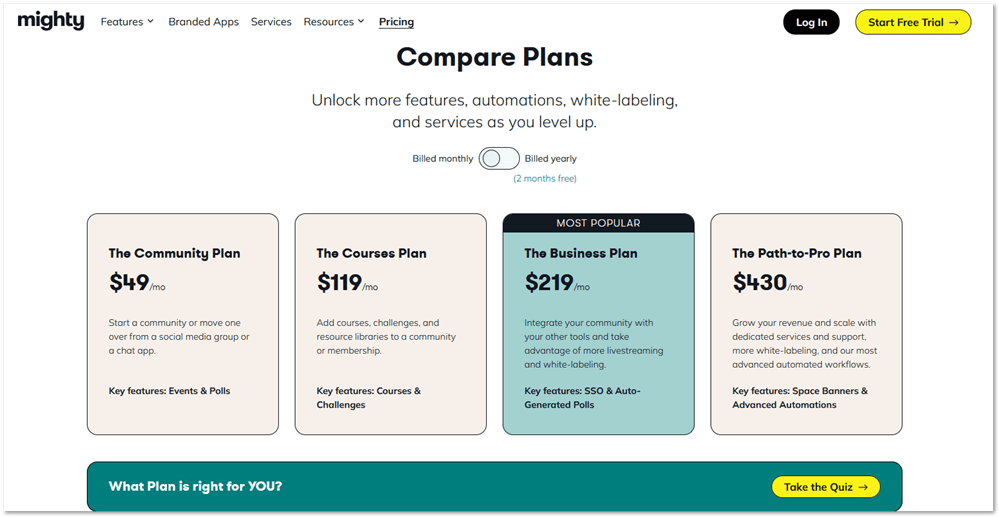
There are four plans to choose from when you join Mighty Networks. The most popular plan is the Business Plan which costs $219/month or $179/month if you decide to pay annually. This plan is the most popular because it is the plan all users get when they sign up for the 14-day free trial.
The Business Plan gives you access to everything offered by Mighty Networks on the web including community-building tools and course creation. After the free trial ends, you have the option to choose between this plan and the Community Plan which only costs $49/month but removes the course creation aspect.
The Community Plan is still a great place to start if you’re just learning about building community and want to focus on that before delving into monetizing with courses. You’ll get all the core features including live streaming, the ability to charge for membership to your community, event, Zoom integration, direct messaging, and group chats.
There is also Mighty Pro, which gives you everything available on the business plan but takes your business to its own mobile apps on the iOS and Android stores. Apps and web presence are totally white-labeled so that you can put your brand in focus. Pricing for this plan is only available after talking to a Mighty Networks rep.
For now, you can try everything for 14 days free and start building your community business with the best community platform online at the moment.
2. Circle
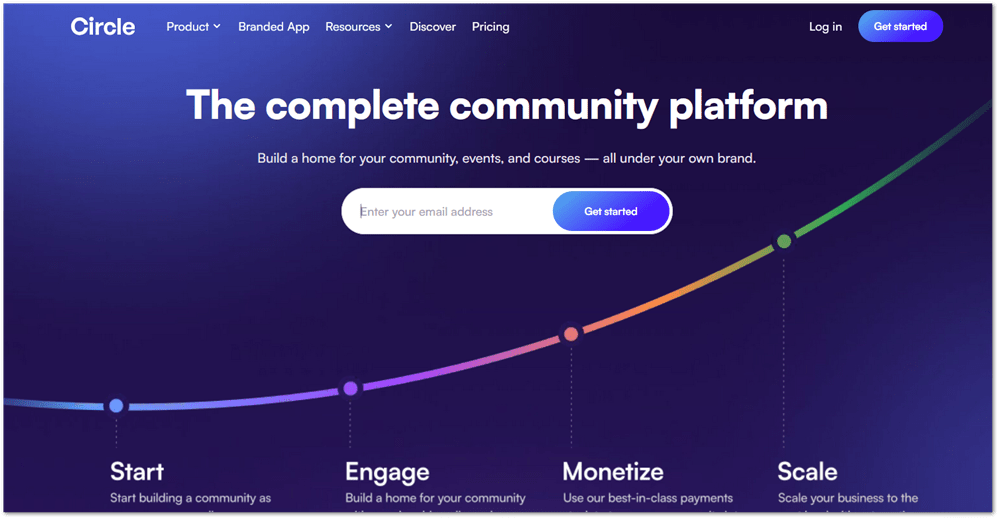
Circle hasn’t been around for too long. They’re going into six years at the time of this update and they’re already one of the biggest names around when it comes to giving creators and brands the tools to build their own communities.
They bill themselves as the “all-in-one community platform” and it’s not hard to see why. They provide a community-first solution for running your online business and also double as a course platform having just introduced course spaces.
On Circle, spaces are the community building blocks that provide the necessary areas for everything to happen. Courses are built in course paces, group chats happen in a chat space and events are created in event spaces. The default spaces are post spaces where creators and members can create engaging discussions.
Circle has all the essential community features such as rich profiles, discussions with native video, images, and rich formatting, group chats, private messaging, event creation, live streaming experiences, and more.
Creators can monetize and empower their communities with courses and charge for access and memberships with flexible payment options and gating. For example, you can create a free community and charge for access to certain spaces or create a paid community and charge for courses or upsell access to certain spaces.
A 14-day free trial without having to enter your credit card details gets you started with Circle. From there you can upgrade to one of three paid plans which all have usage caps on how many members, admins, moderators, spaces, storage, live streaming attendees, and hours among other things. Depending on your communities needs, you’ll know which plan you can start with.
Users can access their Circle community on both native iOS and Android apps. Circle is still very new but already a giant in the community building space with more and more features being added to make them a true “all-in-one platform”.
Key Features
As an “all-in-one community platform”, Circle is packed with features essential to building a thriving community of highly engaged followers.
Here are some key features you’ll find on Circle that help you to build the best community for your brand.
- Rich member profiles show bio, community activity, social links, and more.
- Spaces with specific uses, accessibility, and flexible gating options.
- Engaging posts builder lets you upload videos, add images, gifs, and have rich formatting.
- Chat spaces for group chat.
- Live streaming experiences using native video (one/few-to-many or up to 15 with a Zoom-like experience).
- Member directory with multiple filters lets you find members with shared interests.
- Create unlimited events using native live streaming, Zoom, YouTube Live, or IRL.
- Course spaces with course builders comparable to leading course platforms.
- Zapier integration connects you with thousands of apps.
- SSO integrations let your students log in without Circle credentials.
- Customize your community with CSS/Javascript snippets
- White label removes Circle branding.
- Workflows help you automate tasks.
- Community members can access it from anywhere with the native iOS or Android apps.
Circle Pros
Circle Cons
Circle Pricing
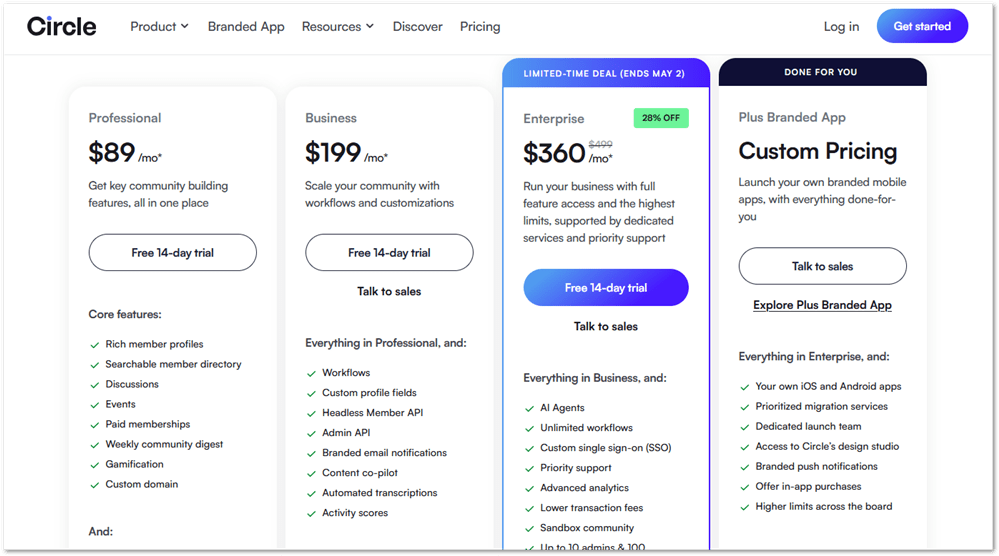
Circle has four paid plans to choose from with either a monthly or annual commitment. Plans start at $89/month for the Professional plan and go up to custom pricing for the Circle Plus Branded App plan.
On the Basic plan, you get access to the core features available inside Circle which include everything from engaging discussions, rich member profiles, and the ability to charge for memberships to unlimited event creation, group chats, and iOS and Android apps to access your community from anywhere.
There are usage caps on all plans including the Basic plan. Most important to know is that you can only have up to 100 members on this plan, 1 admin, 1 moderator, and 10 spaces. Should you need more than allowed, you’ll be required to upgrade to the next plan.
This plan also comes with 4% transaction fees if you decide to charge for memberships. This plan is the only plan where you aren’t allowed to have unlimited members.
Most people choose the Professional plan ($99/month) for a number of reasons. On this plan, you have more allowances for admins (3), moderators (10), spaces (20), and transaction fees are lowered to 2%.
The Professional plan also adds some features not available on the Basic plan. Live streaming experiences and courses are the two biggest ones but you can also have a community without Circle branding and you can use custom CSS and Javascript snippets to customize your community.
The newly added Business plan bridges the gap between the Professional and Enterprise plans with the latter being 4 times costlier than the mid-level plan. At $249/month, the Business plan introduces workflows and users can also have API access for less as this was only previously available at the Enterprise level.
On this plan, you can get free course migrations but only when you choose annual billing.
For bigger brands that need a lot more resources, there is the Enterprise plan which costs $399/month. This doesn’t add a lot of features besides sandbox communities but allows for a lot more admins (10), and spaces (100) among other things that have usage caps. You may also purchase extras on this plan when you exceed the limits.
The Enterprise plan also adds top-notch services like priority email support, a dedicated customer success manager, concierge onboarding, and advanced security and controls.
This pricing model is built for businesses to easily scale from small communities to growing expanding communities. There is no price to get started and you can do so without the need to add any billing information.
3. Thinkific Communities
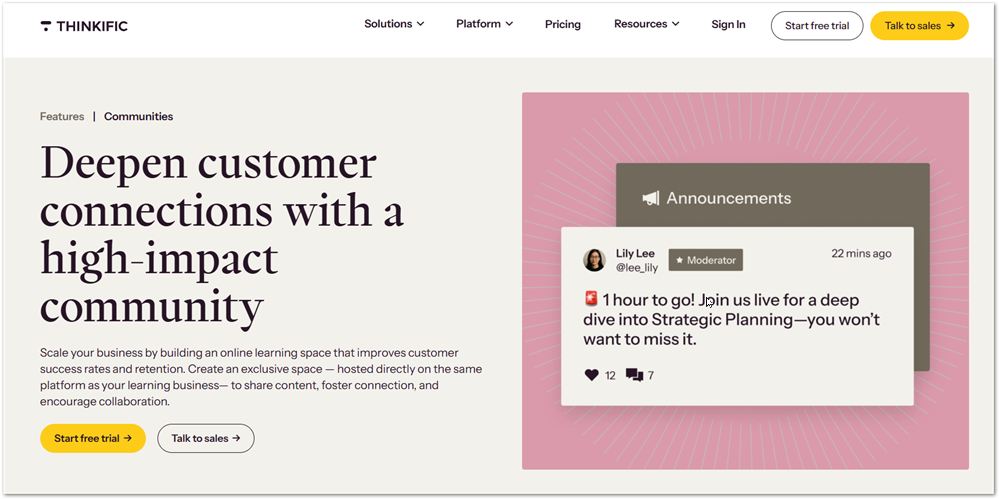
One of the best course platforms creators can run their business on is Thinkific. In fact, here on Trialbear, it is ranked #1 because it is very easy to use, has lots of apps you can use to extend your online school and they have a great deal of educational material for creators.
They’re also #1 because, you don’t need an external community platform for your students to gather. Thinkific communities is available as a product right inside the creator dashboard. All you need to do is add your community and connect your courses so your students can seamlessly navigate between the two.
While Thinkific Communities does not have some of the advanced features other community platforms have, it works because it has all of the features you’ll need in a community platform.
A worthwhile alternative to Facebook Groups, Thinkific communities has threaded discussions, reactions, @mentions, profiles, events and spaces. You can charge for access to your community or you can offer it for free to your course customers.
Communities are available on all Thinkific plans. Depending on which plan you choose, there are limitations. See the plans and pricing section for details.
Thinkific offers a 30-day free trial for creators who want to start their course businesses or run their own communities. If you join for the community platform, you’ll also have access to courses so you can offer either to your core customers.
Key Features
The features you get on Thinkific Communities are what you would expect from any community platform. It’s simple but effective.
And the fact that you have access to the course platform means your members can benefit from the experience of a connected learning community.
Here are some of the key features of the Thinkific community platform.
- Connect courses for seamless navigation.
- Member profiles allow you to learn about other members.
- @mentions let you tag relevant members in conversations
- Threaded discussions allow you to preserve context and continuity.
- Members can react to posts to show appreciation.
- Push notifications on mobile apps for iOS and Android.
- Create live or in-person events.
- Create spaces to keep your community organized.
Other community platform have integrations to help you run your community but remember that Thinkific Communities is part of the whole Thinkific system which already has the course platform built-in. There are already apps and other integrations for you to do what other community platforms can do.
Thinkific Pros
Thinkific Cons
Thinkific Communities Pricing

Thinkific has about 3 plans available, all of which gives you access to build at least one community.
And while many community platforms charge transaction fees even on paid plans, Thinkific does not charge any transaction feeds on any of their plans.
Here are the allowances for the other Thinkific plans.
- Basic ($49/month) – 1 community with 5 spaces / connect unlimited courses / 1 admin
- Start ($99/month) – 1 community with 10 spaces / unlimited courses / 1 admin
- Grow ($199/month) – 3 communities with 20 spaces / unlimited courses / 2 admins
The Plus plan, which is normally for bigger organizations and comes with custom pricing is the only plan that offer unlimited communities with unlimited spaces.
Also, if you want to offer the mobile app experience to your students and members, you’ll need to begin with the Start plan.
Thinkific offers a 30-day free trial to try out Thinkific Communities. If you want to offer a high quality course experience as well as community, Thinkific might be the platform for you.
4. GroupApp
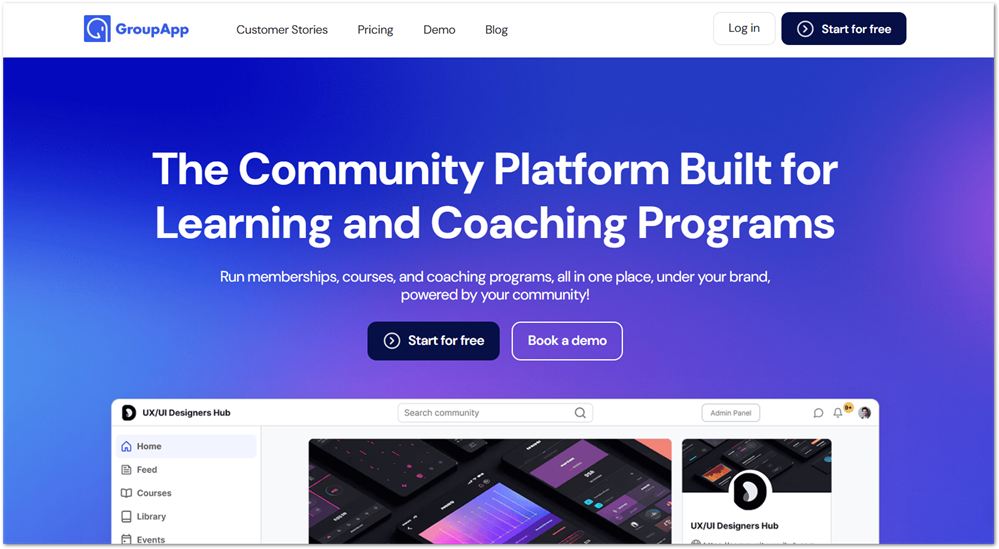
GroupApp isn’t nearly as popular as the first three community platforms but they’re a great option to consider.
With solid community features and the ability to create courses, brands, and creators can build a learning community around their expertise. You can expect community features like rich discussions, profiles, messaging, and group chats which are standard with any platform of this type.
There is no live streaming feature available as yet but this is in the works and will come to GroupApp soon. The same goes for mobile apps for both iOS and Android smartphone users.
Creating a community with GroupApp is easy and the settings are very flexible allowing you to run your community the way you want it. You can charge for memberships or run a free community and charge for courses and other products such as digital downloads or standalone channels.
Channels are like discussion areas in GroupApp which would work like spaces or forums categories. You can create channel groups and then organize related channels within these groups.
The admin area lets you control a lot of aspects of your community including creating courses and events, sending emails, organizing your library, segmenting your members, or applying integrations. You can also find your personal account settings here as well.
There are a few complaints I have about GroupApp which may or may not affect your own decision to choose this platform. They aren’t severe enough that I would completely disapprove of them but the app could use some improvement when it comes to these weak points.
First, the course builder is a bit clumsy. You can add sections and lessons but there are no indicators to mark where lessons are being created and no previews. You can publish, view and then edit your course so you can see how it appears publicly. After the first time, you totally get the hang of it and it’s a minor issue.
Then there is the lack of a number of sales features such as an affiliate program, the ability to bundle products, coupons, or other features like bump sales. Again, not a big deal for me but it would be great to have some of these to make it easier to promote sales.
Having flexible settings where you can offer channels, courses, and other library products for sale outside of the community as an option is a great way to make up for some of these shortcomings but it would make the platform even more powerful if the features were added.
To check out GroupApp, you can start with either a free account or a 14-day free trial on any of the paid plans. Free accounts have limitations and you’ll need to upgrade when you exceed the limits. Free trial users get full use of paid plan features but you cannot go back to a free account once your trial expires. I’d still recommend taking the free trial.
Key Features
GroupApp, though not as complete as other platforms mentioned above, has some very solid features for building your community. Evidently, a new player in this space, more than 600+ brands are using the platform to build their brands and work with these key features.
Here is a summary of the key features available through GroupApp for building your own learning community.
- Member profiles allow members to learn about each other from their bios and links.
- Channels can be used for discussions or read-only posts. Flexible settings allow you to sell memberships, limit visibility and set access levels.
- Your community library contains helpful resources that you can make free or sell downloadable items like guides and videos.
- Direct message other community members or join the group chat.
- Create events with RSVP that your members can attend online via Zoom or in real life.
- Schedule posts to automate your content creation.
- Native email marketing allows you to send messages to your members with segmentation.
- Course creation turns your community into a learning platform.
- Drip-schedule your course to control when students get access.
- Customize your community to fit your branding by changing colors and setting your logo.
- Native integrations and Zapier allow you to do more.
- Flexible settings let you control visibility and access levels
- Convenient landing page builder lets you create the page your invites see.
Live streaming and mobile apps will likely be key features soon to be added to this list once they’re available.
GroupApp Pros
GroupApp Cons
GroupApp Pricing
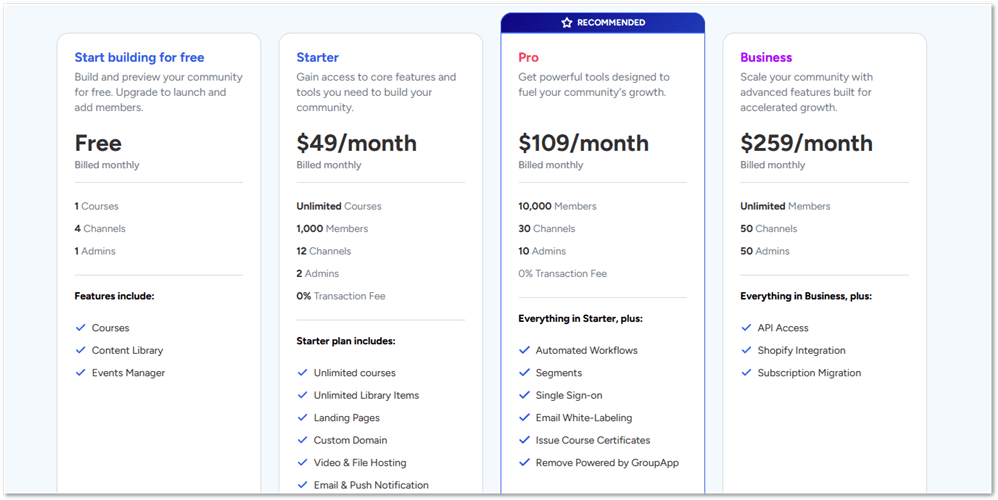
GroupApp has three paid plans, all of which you can start for free with a 14-day trial. There is also a fourth plan which is the free plan. It is free forever but very limited in terms of features and allowances and it also carries a 5% transaction fee if you do decide to take payments.
On the free plan, you’re limited to the core features of GroupApp which means that you can have the community platform features (profiles, up to 3 channels, messaging, and group chat), 1 online course, membership subscriptions, and event creation.
You’re limited to only 100 members on the free tier so if you’re growing on this plan and exceeding that limit, it’s time to upgrade to a paid plan.
All paid plans have a free trial so that you can try out the paid features and decide if GroupApp is for you. The 14-day free trial does not automatically go back to a free account when the trial expires and you’ve canceled.
Paid plans start with a Basic Plan which costs $39/month or $29/month if paid annually. This plan gets you a lot in terms of features and you could get unlimited courses and everything else in the free tier. Zapier integration, custom domain, and email support are also added.
The member limit for the Basic plan cap at 1000 members. You can also set up to 10 channels in your community and have up to 3 team seats.
The recommended plan to be on is the Pro plan ($99/month or $89/month on annual) which gives you access to all the features GroupApp has to offer. They also give you more than enough resources to work with. On the Pro plan, you get up to 10,000 members, 30 channels, and 10 team seats.
For features, you’ll get everything from Basic and you can now drip schedule your courses, schedule posts and emails to your members, and create segments. If you want your members to log in with Facebook or other social accounts SSO is available on Pro.
Finally, there is the enterprise-level plan for big brands and corporations that have huge followings. This plan is called the Premium plan and allows up to 100,000 members. You get 100 channels and up to 100 team seats.
The Premium plan doesn’t really add many features aside from custom OAuth for Single sign-on. For $499/month or $489/month on annual billing, you’ll get a lot more resources plus an account manager and 1:1 onboarding and setup.
For right now, the best plan to go with is the Pro plan if you want to try out all of GroupApp’s currently available features. You can start with a 14-day free trial and try all the features in the next two weeks before you make a decision.
5. Uuki

Another great option if you’re looking for a community platform is Uuki. This platform provides all the necessary features for you to grow loyal memberships while providing spaces for content, discussions, events, chats and courses.
Solid native features plus convenient integrations provide everything creators need to grow their community making Uuki a good alternative to Facebook. At least, it’s one where you own your own platform, make the rules and run your business the way you want.
There are some features that Uuki does not have which might make some other options on this list more appealing. For example, there is no native video which means you have to rely on embeds for events and courses. This also means there is no live-steaming capabilities available unless you want to work with Zoom.
In terms of integrations, there are a few useful ones but surprisingly there is no Zapier available when possible all other competing community platform offer this. You can still rely on webhooks though.
Some strong features include gamification and AI-assisted course creation. You can applaud for the fact that there is no cap on the number of members you can have in your community on all Uuki plans.
Uuki plans are very competitive and affordable. Starting at just $19/month for access to all the core feature and going up to $249/month for the most advanced tier. However, you need to factor in transaction fees into the cost. They’re the highest I’ve seen with the $19/month plan taking 8%, then 5% for the mid-tier plan before going down to 1% on their highest plan.
Community support is also a big part of using Uuki. They have their own built in community which you’re prompted to sign up to when you register. It is here you’ll find all of the support you need including getting your questions answered or checking out the knowledge base and any courses offered.
To get started with Uuki, they offer a 14-day free trial which makes way for a free plan if you’re not quite ready to commit. For more on Uuki, you can read my full review where I test the platform and tell you about my experience.
Key Features
While there aren’t many standout features available on Uuki, the platform still provides some solid features for creators who want to grow communities without settling for whatever Facebook and other social platforms give them.
Here are a some of the key features available to creators and brands who choose Uuki.
- Flexible spaces to create discussions, events, posts, courses and more.
- Gamification rewards your members and fosters engagement and retention.
- AI-assisted course creation makes the process easier for you.
- Member profiles allow others to learn about you and connect.
- Group chats and private messaging help build stronger connections.
- Sell memberships by turning on Stripe to accept payments.
- Create courses to educate your community.
- Grow your community with unlimited members on all plans.
- Android app lets you manage your community on the go and gives your members access from anywhere.
- Remove Uuki branding with white-label community.
Native video and live streaming would be great additions to this list but as of this writing, they’re just not available. This to me is one of the biggest ways Uuki could be improved as a community platform that wants to compete with Facebook groups.
Uuki Pros
Uuki Cons
Uuki Pricing

Uuki is competitively priced when compared to other community platforms and features three premium pricing tiers.
There’s also a free trial of 14-days to get started and that eventually goes to a very limited free plan which you can use until you decide to upgrade.
The three plans, which can be paid monthly or annually, are:
- Starter – $19/month ($15/month billed annually)
- Pro – $79/month ($65/month billed annually)
- Advanced – $259/month ($205/month billed annually)
The Starter plan offers the core features available on Uuki. There are some things to consider if you decide to go with this plan.
While you can have unlimited members on all plans, there are limits on each plan. On the Starter plan, you can only have 1 admin, 1 moderator, and up to 10 spaces. If you decide to take payments, you can expect to pay 8% in transaction fees.
The Pro plan increases the resources to 3 admins, 10 moderators, and up to 20 spaces while reducing transaction fees to 5%.
All of the features from the Starter plan are included and the plan adds the ability to remove Uuki branding, advanced reporting, API access, custom SSO, and more.
The most expensive plan offered is the Advanced plan. This is for power users and has the most resources. You can have up to 10 admins, 100 moderators, and 100 spaces. Transaction fees are lowered to 1%.
Everything in Pro is available plus you get a dedicated account manager, priority support, email white-labeling and more.
Which plan you decide to go depends on your needs as a creator or brand. You can get started with a 14-day free trial to check out the core features and you can even schedule a demo call before you upgrade.
6. Heartbeat

Heartbeat is billed as “an all-in-one platform for community businesses”. It was designed to replace a lot of what creators needed to run online businesses effectively.
The platform has a lot of features that you’ll expect from a community platform. You can host discussions, create and sell courses, host events, offer content and a lot of other things.
Sadly, this is yet another platform that doesn’t have native video so you’ll have to host your course content on an external host like YouTube or Loom.
If you’re comfortable doing that then Heartbeat can work for you and is an excellent alternative to Facebook groups. Hosting your own community is easy and you can do it from your own domain.
Your members will be able to access your community on mobile via iOS or Andoid apps. Heartbeat also has a desktop app which can be useful for creators.
And just like all the other community platforms on this list, you can get started with Heartbeat by activating a free trial. Heartbeat gives you 14 days free and you don’t need a credit card to get started either.
After that, you can choose from any of the three paid plans starting at $49/month.
Key Features
Heartbeat has a great feature set that puts their platform above some of the others on this list.
Here are some of the key features you can find within Heartbeat’s all-in-one community platform.
- Threaded discussions and chats help foster engaging discussions between members.
- Create courses whether evergreen or cohort-based to empower and educate members.
- Create events, track attendees and send automated reminders.
- Document repository lets you upload content, save threads, links and more.
- Searchable member directory allows you to find other community members.
- Voice and video rooms let you connect more personally with other members.
- Track community growth and activity with reporting and analytics.
- Connect Stripe and manage payments for subscriptions, tiers, events and more.
- Use a custom domain and customize to fit your brands colors.
- Affiliate program managements allows you to reward members for referrals.
Heartbeat Pros
Heartbeat Cons
Heartbeat Pricing

There are three plans to choose from if you decide to go with Heartbeat after the 14-day free trial.
The Starter plan is the most popular plan and it is easy to see why. At $49/month, it is affordably priced for a plan that has all the core features and a 1000 member limit that allows you to grow comfortably.
You’ll also find custom domains and brand colors as well as any necessary integrations like Zoom and Zapier.
The Growth plan, as the name suggests is for when you’ve outgrown the Starter plan. The only difference between the Starter and Growth plans is that the limitation on members have been removed and you can now accept unlimited members. Priority customer support is also given to Growth subscribers. This plan is priced at $129/month.
If you want full API access, you’ll have to go with the Business plan for $399/month. This plan has everything the Growth plan has and in addition to API access, you can get 1:1 onboarding and setup as well as custom technical support.
For most brands and creators, the Starter plan should be a good starting point especially if you’re now beginning to grow your community. If you’re transferring your community from another platform, you may need to start with the Growth plan depending on your membership base.
Annual billing plans are available and come at a discounted price. You can get started with Heartbeat with a 14-day free trial without the need to enter your credit card info.
7. Skool
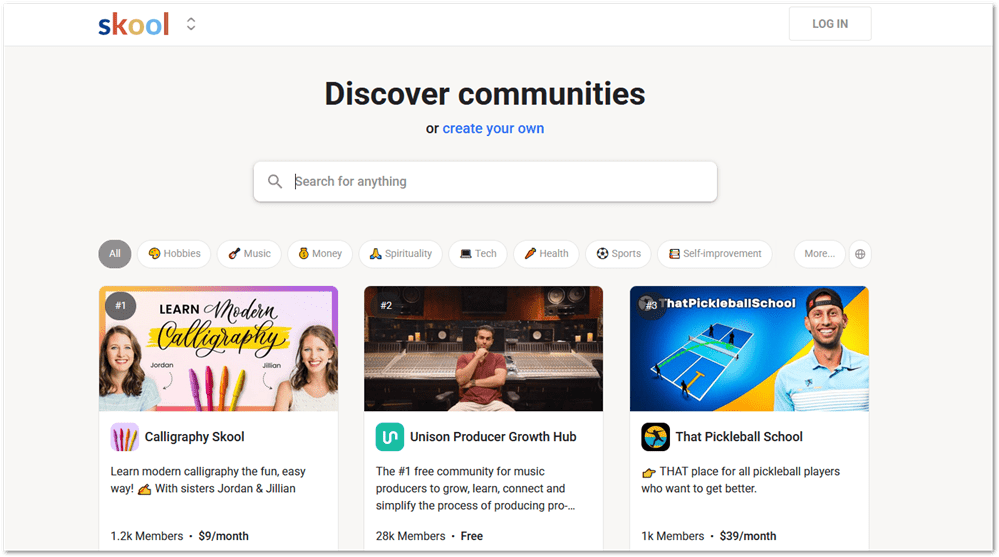
Skool is another option for building a community-based business online. This community platform for creators lets you build a community, add courses, events and membership access.
One of the strong-points of this community platform is gamification. Members can earn points while participating in discussions which makes it fun and rewarding. They can get to different levels while accumulating points and unlock courses and other predetermined rewards.
Gamification helps to make Skool communities active as it fosters engagement and retention.
Skool is a bit different from the other community platforms on this list as you can only create one community on your plan. There is also only one plan that costs $99/month. If you want to create more communities, you’ll need to pay another $99/month. With this fee, you can access all features and have unlimited members and unlimited courses.
The platform is relatively new and has been developing very quickly over the past 6 months adding important features like checkout so that you can charge for community access, apps for iOS and Android, and a lot more.
Support at Skool is also a big deal as their own community is accessible to you, the creator, alongside your own. The Skool community is very active and very helpful. Questions get answers pretty fast and problems you may run into get help, sometimes with a personal touch.
Just like all the other platforms on this list, you can access Skool with a free trial. In this case, you get 14 days free to build your community before you’re required to pay. Your credit card info is required to get started but you can cancel at any time.
Key Features
Skool has a lot of great features to help creators build and run thriving communities that their members would love.
They did not start with a perfect platform and at one time there were a lot of important features missing. At the time when I took the free trail, they didn’t even have a way for you to charge members for community access.
In the past months though, they’ve added a lot of great essential features and they’re still adding more. Here’s a list of some of the best features you’ll encounter on Skool.
- Community switcher lets you access any groups you’re a member off or any groups you’re managing from one dashboard.
- Rich user profiles let you see members info, websites, social media handles, and more.
- Gamification rewards users for participating and can be great fro retention.
- Create courses to empower and educate your community members.
- Events allow you to connect online and in-person.
- iOS and Android apps allow users to learn and interact on the go.
- Skool payments is a cheaper option than Stripe and lets you charge members for access.
- Skool’s support group for creators is just a click away.
- Zapier and other native integrations to connect your favorite apps.
I’m not sure if I saw something about them adding video hosting but that is one feature hey still don’t have at this time. You’ll have to use external video hosting that is supported – Loom, YouTube, Wistia, Vimeo and Bunny.net. Hopefully they’ll add this in the future.
Skool Pros
Skool Cons
Skool Pricing

There are no pricing tiers or plans to choose from when you subscribe to Skool. You pay $99/month to create one community with all the features included plus unlimited courses and unlimited members.
If you decide to start another community, you’ll need to pay another $99 but you can manage all your communities from the same dashboard.
Most other community platforms have lower-priced plans where you can start a single community but they’ll probably allow multiple communities at around similar priced plans.
There is also no annual billing option for creators to save money. One good thing is that once you join Skool, you automatically become an affiliate and can refer other creators. Affiliates get 40% of each sale so you’ll only need 3 sales to offset the cost of your monthly billing. Furthermore, Skool will apply any commissions you make to your monthly bill before paying you so you’re essentially being paid to be a Skool creator.
You can get started with a free trial but you’ll need to enter your credit card info. You can cancel at any time and continue using Skool until your trial expires.
Final Words
Commmunity-first business is a rising trend in not only the online education space, but alone in online marketing in general. The demand for the best community platform is increasing going into 2025.
Creators want community platforms where they can interact with their students while they learn and also stay in touch with them on mobile.
The best community platforms feature native video, mobile apps (both native or white label) and give creators options to charge for member access.
In my assessment, the top 3 community platforms are:
- Mighty Networks – best overall and great option if you need a white-label app
- Circle – Best all-in-one community platform and can be integrated into Teachable and Thinkific if you’re already using these course platforms.
- Thinkific Communities – Best community platform for course creators.
The platform you choose will depend on your needs as a creator. The best thing is that they all have a free trial for you to get started so there is really no harm in trying them all.




